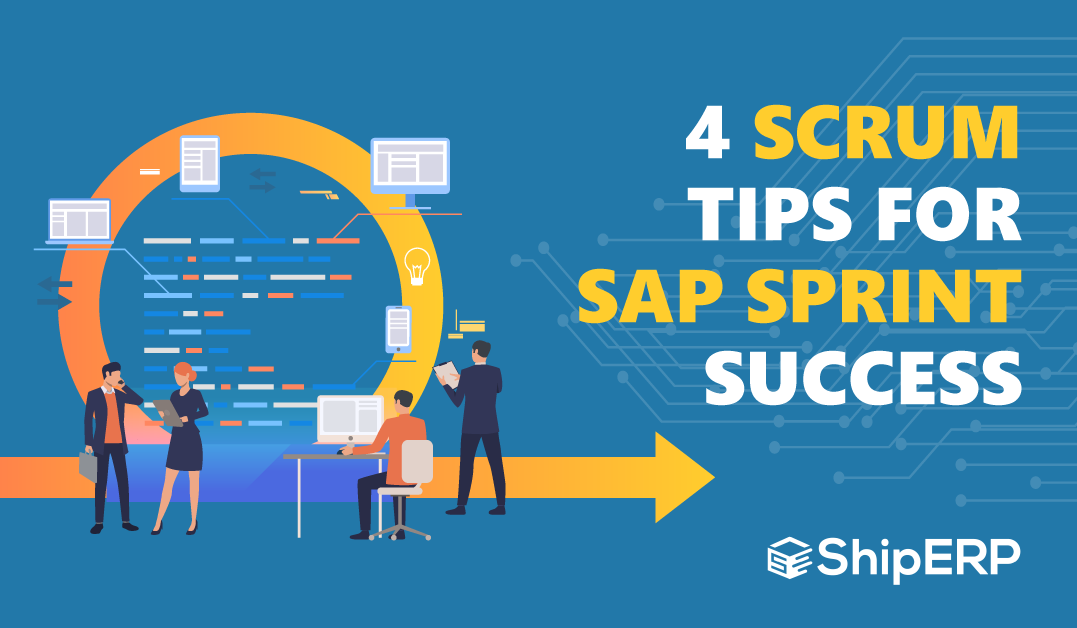
4 Scrum Tips To Guarantee SAP Sprint Success
Client requirements are constantly changing, so you need to adopt a flexible approach for your SAP implementation. Aim for success with Scrum and sprints!
To meet market demands, we’re always looking for the fastest and most efficient way to deliver the SAP software to our customers. But sometimes, your clients won’t know what they need before they see for themselves how the solution works.
It results in change requests when you’re far along the SAP development process. It can be difficult to go back and make those corrections, especially when you’re in the later stages of the project.
So, what does your SAP development methodology need? Flexibility!
The tips listed below are directly from our ShipERP R&D team! Establishing a common foundation and frequent communication avenues for your team will lead to fast and flexible delivery of software for high satisfaction among your clients. Let us know how these tips work out for you!
Using an Agile Methodology in SAP
The agile methodology provides the flexibility you need to meet changing requirements by emphasizing the quick delivery of a software application in complete functional components. It solves challenges presented in a traditional waterfall or ASAP (Accelerated SAP) method in the implementation process.
Migrating to a new solution may be intimidating but breaking it down into simple steps can set your software project up for success. Learn more.
All About Scrum and Sprints
To understand Scrum, let’s define a few key terms so we’re all on the same page:
- Product Backlog Items (PBI): items and tasks that need to be completed in order to create, maintain, and sustain a product
- Increment: the sum of all PBIs completed during a sprint; a working piece of software where the sum of all increments forms a product
- Sprint: a predefined period for the scrum team to complete an increment of PBIs
Scrum is an agile framework for team collaboration that focuses on delivering the highest possible value in the most efficient and timely manner. To achieve efficiency, a list of PBIs are divided into increments to be completed by the scrum team during each sprint.
The Scrum framework promotes a continuous workflow that allows priorities and requirements to change as the project progresses which makes it a great development methodology if you’re seeking flexibility!
Applying Scrum and Sprints to SAP
The success of your SAP solution depends on the speed and effectiveness of the software to add value to your organization. An agile implementation methodology enables your business to generate faster results, receive immediate insights into the value, and improve progress monitoring.
As each sprint is continuously tested and approved, the increments build up to form a firm foundation in the SAP software. Some SAP solutions, like ECC or HANA, may seem too large-scale to break down into workable sprints, but its large scale is more of a reason to adopt a Scrum framework!
You don’t want to run into issues where you must backtrack to make corrections when those could’ve been resolved with an agile methodology.

Scrum Tips for SAP Sprint Success
As you move forward with an agile framework like Scrum, keep these tips in mind to run successful sprints in your SAP implementation!
1. Establish Clear Definitions
Take a moment to align your team’s understanding of Scrum and the agile methodology process before you take your first steps. The extra step will help your team build a strong foundation for collaboration and avoid any confusion. Not only do you need to have a shared understanding of the Scrum and sprint process, but your team also needs clearly explained Definition of Ready (DoR) and Definition of Done (DoD).
Set your team up for success by providing reference materials with the definitions your team will use throughout the project. Sprint planning is a must in your process!
2. Set SMART Goals
Aside from a shared understanding of Scrum, take the time to set deliverable sprint goals! Remember the acronym SMART as you and your team formulate the sprint goals:

A proper SMART sprint goal can help a team focus and have the flexibility to complete an increment by the end of a sprint. It can also help the team understand the purpose and impact of the work they’re doing which will motivate your team.
3. Hold Daily Standup Meetings
It’s important for your Scrum team to hold daily standup meetings to answer three important questions:
- What did you achieve yesterday?
- What will you work on today?
- What obstacles are you running into?
Having daily standup allows your team to communicate, provide visibility on task achievements, and help each other to remove obstacles that may prevent the team from meeting the sprint deadline. The standups are another example of what makes the Scrum framework flexible and agile.
4. Conduct Regular Sprint Reviews
A sprint review is an opportunity for you to inspect and adapt! The Scrum team can showcase what the members have been working on to the clients and receive immediate feedback; whether the team is on the right track or whether changes need to be made. It's a collaboration opportunity to quickly prioritize tasks and adapt changes.
Have a better idea of how to succeed in your SAP sprints now? A detailed plan with defined terms and SMART goal will set a strong foundation for your Scrum team. Then, add in the constant flow of communication of daily standups and regular reviews, and you’re set to succeed!
Other SAP Project Success Resources:
What else do you need to succeed in your SAP integration projects?
- A skilled digital transformation team that can work together cohesively to achieve your goals
- A detailed SAP blueprint to outline a solid foundation of the SAP project

